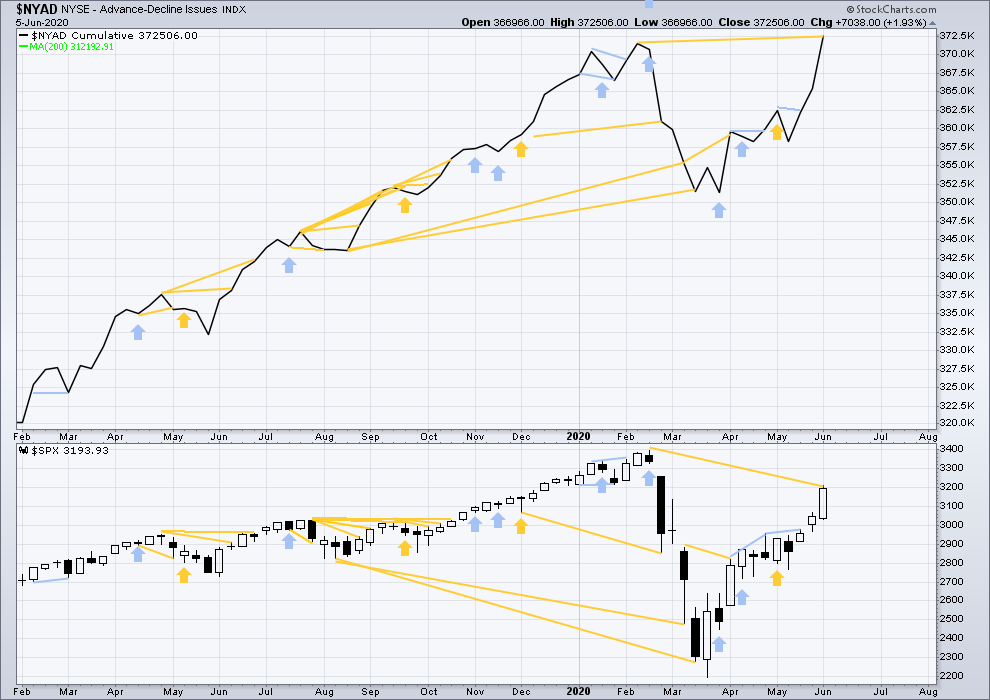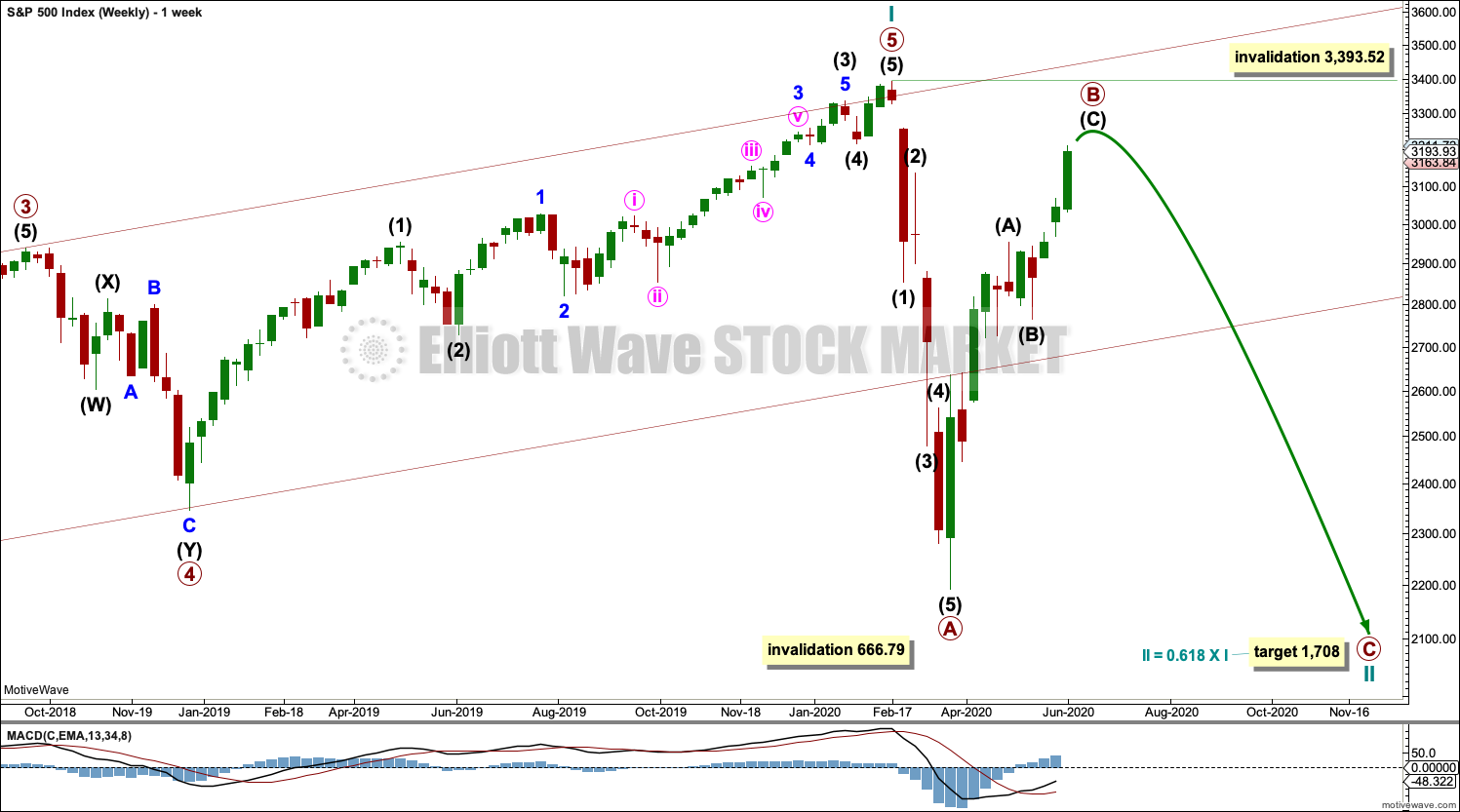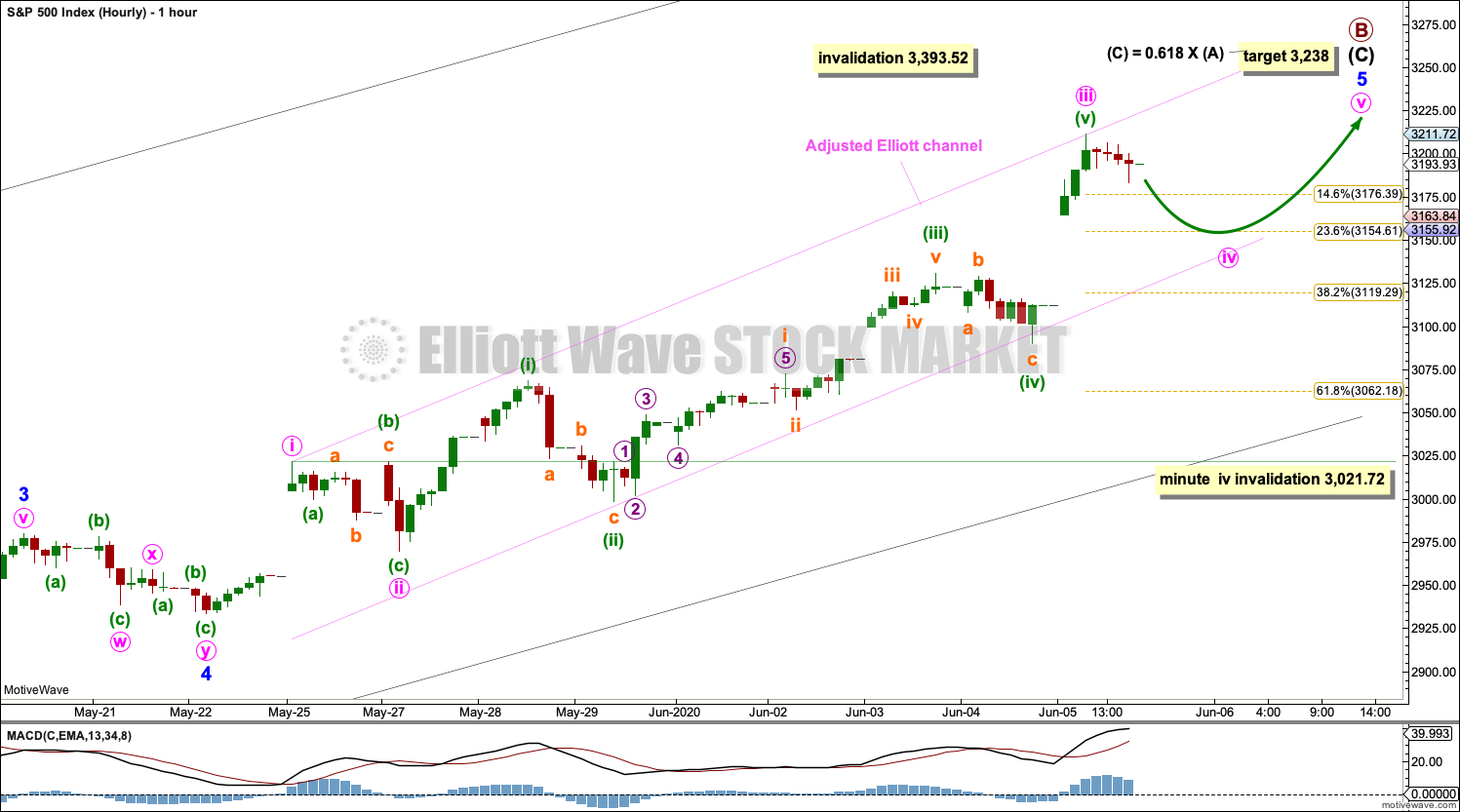S&P 500: Elliott Wave and Technical Analysis | Charts – June 5, 2020
Summary: The next target is at 3,238. Use the lower edge of the Elliott channel to indicate where support may be found on the way up.
The following points would provide confidence that this upwards wave is over:
1. A bearish candlestick reversal pattern.
2. A breach by downwards movement of the black upwards sloping Elliott channel on the main daily chart.
3. A new low below 3,021.72.
When this upwards wave is over, it would then be followed either by a deep multi-week pullback or the continuation of a bear market.
At the end of this week, new all time high from the AD line suggests new all time high from price may follow soon. However, inversion of the yield curve in May 2019 suggests an economic recession to begin by May 2021 at the latest. This data is contradictory but may be resolved by the third alternate monthly Elliott wave count.
The biggest picture, Grand Super Cycle analysis, is here.
ELLIOTT WAVE COUNTS
MAIN MONTHLY CHART
The 0.236 and now also 0.382 Fibonacci ratios of cycle wave I have both been passed. The next Fibonacci ratio in the sequence is used for the next target for cycle wave II to end.
The channel drawn about cycle wave I is drawn using Elliott’s first technique. This channel looks text book perfect. The channel is now strongly breached confirming an end to the bull market, which began in 2009, and confirming a new bear market to follow.
Cycle wave II may not move beyond the start of cycle wave I below 666.79.
Cycle wave II may last about one to two years in total. In the middle should be a B wave bounce or consolidation that may last some months and which may end now next week.
At this stage, I now have two weekly charts looking at two different Elliott wave structures for cycle wave II.
MAIN WEEKLY CHART
This main Elliott wave count expects that the bull market beginning in March 2009 was cycle wave I of Super Cycle wave (V). The trend change in February 2020 may have been only at cycle degree. Cycle wave II may last from one to a few years.
Cycle wave II would most likely subdivide as a zigzag; thus far that looks like what is unfolding. When primary waves A and B may both be complete, then the target may be calculated using a Fibonacci ratio between primary waves A and C. At that stage, the final target may change or widen to a zone.
Cycle wave II may not move beyond the start of cycle wave I below 666.79.
MAIN DAILY CHART
Draw the wide maroon trend channel carefully: draw the first trend line from the end of primary wave 1 at 2,093.55 (December 26, 2014), to the end of primary wave 3 at 2,940.91 (September 21, 2018), then place a parallel copy on the end of primary wave 2 at 1,810.10 (February 11, 2016). The channel is fully breached indicating a trend change from the multi-year bull trend to a new bear trend. Resistance at the lower edge has been overcome; price has closed above this trend line.
Cycle wave II may subdivide as any Elliott wave corrective structure except a triangle. It would most likely be a zigzag (zigzags subdivide 5-3-5). Primary wave A may be a complete five wave impulse downwards. Primary wave B may not move beyond the start of primary wave A above 3,393.52.
Draw a channel about primary wave B using Elliott’s technique for a correction. Draw the first trend line from the start of intermediate wave A to the end of intermediate wave B, then place a parallel copy on the end of intermediate wave A. Intermediate wave C may find resistance at the upper edge of the channel. While intermediate wave C unfolds higher, any smaller pullbacks within it may find support at the lower edge of this channel.
When this channel is breached by downwards movement, it would then indicate the bounce labelled primary wave B may be over and the next large downwards wave labelled primary wave C may then have begun. This is how the channel will be used this week.
MAIN HOURLY CHART
Intermediate wave (C) may continue into next week.
Intermediate wave (C) must subdivide as a five wave motive structure, either an impulse or an ending diagonal. This first hourly chart considers the more common impulse, so it has a higher probability.
Minor wave 5 within intermediate wave (5) may be extending. Minute waves i, ii and iii within minor wave 5 may be complete. Minute wave iv may not move into minute wave I price territory below 3,021.72.
Draw a channel about minor wave 5 as shown: draw the first trend line from the ends of minute waves i to iii, then pull a parallel copy down to contain all of minor wave 5. Minute wave iv may find support about the lower edge of the channel.
If this wave count is invalidated in the short term with a new low below 3,021.72, then it may be possible that primary wave B is over. A breach of the wider black channel copied over from the daily chart would add substantial confidence to that view.
ALTERNATE WEEKLY CHART
This alternate weekly chart considers a different possible Elliott wave structure for cycle wave II. Cycle wave II may subdivide as any corrective structure except a triangle. This wave count considers a flat correction may be unfolding for cycle wave II.
Flat corrections subdivide 3-3-5 and require primary wave B to retrace a minimum 0.9 length of primary wave A. That minimum has not yet been met.
The common range for primary wave B within a flat correction is from 1 to 1.38 times the length of primary wave A. Primary wave B may make a new high beyond the start of primary wave A as in an expanded flat. There is no Elliott wave rule which states a maximum length for primary wave B, so there is no rule to apply to determine an upper invalidation point for this wave count.
FIRST ALTERNATE MONTHLY CHART
This wave count is the same as the first monthly chart, but the degree of labelling is moved down one degree. It is possible that the all time high was the end of a Grand Super Cycle first wave, and a huge market crash to historic lows may have just begun.
This wave count requires a five wave structure to unfold lower at the monthly chart level. That would be incomplete. No second wave correction within the first five wave structure downwards may move beyond the start of its first wave above 3,393.52.
FIRST ALTERNATE DAILY CHART
This alternate daily chart follows the First Alternate Monthly chart.
By simply moving the degree of labelling in the bull market beginning March 2009 up one degree, it is possible that a Grand Super Cycle trend change occurred on February 19, 2020. The bull market from March 2009 to February 2020 may have been a complete fifth wave labelled Super Cycle wave (V).
A bear market at Grand Super Cycle degree may be expected to last at least a decade, possibly longer. Corrections for this market tend to be much quicker than bullish moves, and so a fair amount of flexibility is required in expectations for duration of the different degrees.
Grand Super Cycle II would most likely subdivide as a zigzag, although it may be any corrective structure except a triangle. It should begin with a five down at the weekly chart time frame, which would be incomplete.
The first wave down on the daily chart is labelled cycle wave I. If this degree of labelling is wrong, it may be too high; it may need to be moved down one degree.
Following cycle wave I, cycle wave II may be continuing higher as a zigzag. Cycle wave II may not move beyond the start of cycle wave I above 3,393.52.
When cycle wave II may again be complete, then a target for cycle wave III may be calculated.
FIRST ALTERNATE HOURLY CHART
Cycle wave II may be a continuing higher as a single zigzag. Hourly wave counts for the main daily chart work in the same way for this alternate. The degree of labelling for this alternate is all one degree higher.
SECOND ALTERNATE MONTHLY CHART
This alternate monthly chart labels the bull market from March 2009 to February 2020 in exactly the same way as the the main wave count. Thereafter, the difference is in the structure of cycle wave II.
It is possible that cycle wave II may be complete as a relatively brief and shallow zigzag. Cycle wave III may be beginning. Cycle wave III may only subdivide as an impulse.
Primary wave 1 within cycle wave III may be nearing completion. When primary wave 1 may be complete, then a multi-week pullback should begin for primary wave 2 that may not move beyond the start of primary wave 1 below 2,191.86.
This wave count is very bullish and is contradicted by inversion of the yield curve back in May 2019. Inversion of the yield curve suggests the beginning of a recession a few months to about two years afterwards. This wave count expects a bull market to continue for over two years.
THIRD ALTERNATE MONTHLY CHART
This alternate monthly chart is new. This alternate monthly chart labels the subdivisions of the long bull market differently. The channel is a best fit.
There is a reasonably close Fibonacci ratio between cycle waves I and III. It would be less likely that cycle wave V would exhibit a Fibonacci ratio to either of cycle waves I or III, as the S&P rarely exhibits Fibonacci ratios between all of its actionary waves. The target for cycle wave V would best be calculated at primary degree. That can only be done when all of primary waves 1, 2, 3 and 4 are complete. That cannot be done yet.
There is alternation between a zigzag of cycle wave II and a flat correction of cycle wave IV.
Cycle wave V must subdivide as a five wave motive structure, most likely an impulse. Primary wave 1 within cycle wave V may be nearing completion. Primary wave 2 should then unfold as a multi-week pullback and may not move beyond the start of primary wave 1 below 2,191.86.
This alternate wave count is bullish, but less so than the second alternate. This alternate wave count may still fit the prediction from the inversion of the yield curve, and it may allow for time for the AD line to diverge from price as price makes final highs before the end of the bull market.
Cycle wave V may last from one to several years. If inversion of the yield curve is followed by a recession two years afterwards, and if the stock market is a leading indicator of a recession (as it normally is), then cycle wave V may end a little before May 2021.
TECHNICAL ANALYSIS
MONTHLY CHART

Click chart to enlarge. Chart courtesy of StockCharts.com.
Double bearish divergence between price and RSI along with two bearish candlestick reversal patterns has been followed by downwards movement, which meets the technical definition of a bear market in that more than 20% of market value was lost.
So far a V bottom has formed. There is nothing in this chart which identifies with confidence whether or not the V bottom is sustainable. It is possible that a new bull market may develop. It is also possible that the bear market may continue and the bounce may be a Dead Cat Bounce. Weak volume does suggest the bounce may not be sustainable, but there is evidence in this chart that price can rise for some years on light and declining volume.
WEEKLY CHART

Click chart to enlarge. Chart courtesy of StockCharts.com.
The breakaway gap has its upper edge at 3,328.45. This may offer strong and final resistance. If this gap is closed, then it would suggest that the downwards wave which followed it is complete. That would suggest a more bullish Elliott wave count should be considered as more likely.
This week a strong upwards week has some support from volume. More upwards movement next week looks most likely.
DAILY CHART

Click chart to enlarge. Chart courtesy of StockCharts.com.
The breakaway gap of 24th February has its upper edge at 3,328.45. A bearish analysis remains reasonable while this gap remains open. If this gap is closed, then a more bullish analysis that would expect new all time highs would increase in probability.
With volume now more strongly supporting upwards movement, more upwards movement next week looks likely. The gap for Friday may be a measuring gap, but the target would already be met. If this gap remains open, then it would remain a measuring gap; but if it is closed with a new low below 3,128.91, then it would be an exhaustion gap and a trend change would be possible.
BREADTH – AD LINE
WEEKLY CHART

Click chart to enlarge. Chart courtesy of StockCharts.com. So that colour blind members are included, bearish signals will be noted with blue and bullish signals with yellow.
Breadth should be read as a leading indicator.
This week the AD line makes a new all time high. This divergence is bullish and is usually followed by an all time high in price shortly after. This supports the second or third alternate monthly charts.
Large caps all time high: 3,393.52 on 19th February 2020.
Mid caps all time high: 2,109.43 on 20th February 2020.
Small caps all time high: 1,100.58 on 27th August 2018.
DAILY CHART

Click chart to enlarge. Chart courtesy of StockCharts.com. So that colour blind members are included, bearish signals will be noted with blue and bullish signals with yellow.
The AD line has made a new all time high at the daily chart level also. This divergence is bullish and is normally followed by an all time high from price shortly after. This supports either the second or third monthly alternate Elliott wave counts.
VOLATILITY – INVERTED VIX CHART
WEEKLY CHART

Click chart to enlarge. Chart courtesy of StockCharts.com. So that colour blind members are included, bearish signals will be noted with blue and bullish signals with yellow.
This week both price and inverted VIX have moved higher. There is no new divergence.
DAILY CHART

Click chart to enlarge. Chart courtesy of StockCharts.com. So that colour blind members are included, bearish signals will be noted with blue and bullish signals with yellow.
Today both price and inverted VIX have moved higher. There is no new divergence.
INTEREST RATE YIELD
Chart from FRED.
The long-term rate dropped below the short-term rate in May 2019. This is one of the most reliable leading indicators of an economic recession. A recession usually follows several months to two years after this inversion. The stock market is also normally a leading indicator, so it normally turns downwards and begins to fall a few months prior to a recession beginning. Grey shaded areas on the chart are periods of economic recession.
DOW THEORY
Dow Theory has confirmed a bear market with the following lows made on a closing basis:
DJIA: 21,712.53 – a close below this point has been made on the March 12, 2020.
DJT: 8,636.79 – a close below this point has been made on March 9, 2020.
Adding in the S&P and Nasdaq for an extended Dow Theory, a bear market has now been confirmed:
S&P500: 2,346.58 – a close below this point has now been made on March 20, 2020.
Nasdaq: 7,292.22 – a close below this point was made on the March 12, 2020.
At this time, to shift Dow Theory from viewing a bear market to confirmation of a new bull market would require new highs made on a closing basis:
DJIA – 29,568.57
DJT – 11,623.58
Adding in the S&P and Nasdaq for an extended Dow Theory:
S&P500 – 3,393.52
Nasdaq – 9,838.37 (while this point was exceeded intraday on 5th June 2020, price has not closed above it, yet).
Published @ 08:45 a.m. EST on June 6, 2020.
—
Careful risk management protects your trading account(s).
Follow my two Golden Rules:
1. Always trade with stops.
2. Risk only 1-5% of equity on any one trade.
—
New updates to this analysis are in bold.











